4th November 2022
The Spokesmen Cycling Podcast
EPISODE 312: Good Move: How Bicycles Could End the Occupation of Cars in the EU capital of Brussels
SPONSOR: Tern Bicycles
HOST: Carlton Reid
GUESTS: Elke Van den Brandt, mobility minister for Brussels; Luxembourg councillor and EU Committee of the Regions rapporteur for mobility Linda Gaasch; Alison Abrahams from the Casual Cycling Club; Philip Amaral, policy directer of the European Cyclists’ Federation; Kim Smouter of the European Network Against Racism; and Philipp Cerny, author of the European Mobility Atlas.
TOPICS: The burgeoning of bicycling in Brussels
TRANSCRIPT:
Carlton Reid 0:13
Welcome to Episode 312 of the Spokesmen cycling podcast. This show was engineered on 4th November 2022.
David Bernstein 0:27
The Spokesmen cycling roundtable podcast is brought to you by Tern bicycles. The good people at Tern are committed to building bikes that are useful enough to ride every day, and dependable enough to carry the people you love. In other words, they make the kind of bikes that they want to ride. Tern has e bikes for every type of rider. Whether you’re commuting, taking your kids to school, or even caring another adult, visit www.tern bicycles.com. That’s t e r n bicycles.com to learn more.vav
Carlton Reid 1:02
The UK might no longer be in the EU but this Brit recently went to Brussels to talk bikes. I’m Carlton Reid and for today’s episode I’m bringing you a bunch of interwoven interviews with Brussels-based bike advocates and Green politicians. You’ll be hearing from Elke Van den Brandt, the region-city’s mobility minister for Brussels, and I have an interview with Luxembourg councillor Linda Gaasch who successfully pitched an active mobility position paper to the EU’s Committee of the Regions. Alison Abrahams from the Casual Cycling Club explains how she’s getting more women on bikes in Brussels and Philip Amaral of the European Cyclists’ Federation puts the city’s Good Move circulation plan into a wider political persepective. Philip talks about some of the violence that greeted the introduction of this circulation plan, and I meet Kim Smouter who was up close and personal with some of that violence. But first I chat with Philip Cerny, author of the European Mobility Atlas, on the rather busy Rue de la Loi. This is a multi-lane highway from the outskirts into the centre and it has recently been reconfigured a little, with a lane each side taken away from motorists and given to cyclists and e-scooter riders. Naturally, motorists have claimed this reallocation of road space is the reason for the road’s current traffic jams.
If you can hear us above the bothersome road noise here I am with Philip Cerny.
So for what outside all the different EU EU buildings here, and we have
what what is this road? First of all, do you know what the road is?
Philipp Cerny 3:15
It’s Rue de la Loi the main road through the heading through the European headquarters.
Carlton Reid 3:24
And they basically taken where we’re standing amongst all this motor traffic and they have taken lanes away on each each side of the road.
They’ve taken away some space from from motorists and giving it a bit more to pedestrians and to scooter users and to cyclists.
Philipp Cerny 3:40
Exactly. And that’s that’s really helpful because the commission is also
a commission the other institutions are really promoting to, to use the bicycle. They’ve been some
challenges that
in between the commission and department had built too many parking spaces, they weren’t allowed to have so many parking spaces because they expected everybody to take their car to work. But people were actually voting with their feet or with their bicycles to say so because more and more people just notice them. It’s simply possible to get to work by bike.
Carlton Reid 4:21
Now you’ve been working in this this city for a number of years. So this traffic congestion here now isn’t caused by the bike lanes. That’s always been this has always been in a congested Street. Yes?
Philipp Cerny 4:36
It hasn’t changed a bit. It doesn’t.
There’s
better infrastructure for cyclists and pedestrians now. But the car traffic essentially is still the same.
Carlton Reid 4:48
So the the basic accusation from from many people in many cities is when you put the bike infrastructure in, all of a sudden that’s what’s causing the congestion and all you got to do is
Basically just on Google Maps, probably and Google Streetview, where you can actually know that congestion was there there before. So this street was congested before they’ve taken away
car lanes, but it’s still congested.
Philipp Cerny 5:14
And in my opinion, I don’t think that’s going to change anytime soon. It’s
unless the city of Brussels is really going to enforce some stricter access regulations. People will, on one level or another continue to drive into the city.
Carlton Reid 5:37
The mobility Minister Brussels says cars will always have a place in the city and region, but they should no longer rule. Green politician Elke Van den Brandt spearheads the city’s Good Move circulation plan. Here’s the European cyclists Federation’s policy officer, Philip Amaral, to explain more.
Philip Amaral 5:58
Good Move is is a is a mobility plan, like we’ve seen in many other cities. And its main objectives are to
adjust traffic circulation with the aims of reducing the volumes of cars.
Sort of ensuring that some neighbourhoods within the city have lower car speeds lower volumes are more protective of people walking and cycling,
decrease pollution
Elke Van den Brandt 6:35
The goal of this mobility plan. It’s not about transport. It’s not about transporting people from place A to B or transporting goods. It is actually about quality of life and the quality of public space in Brussels.
Carlton Reid 6:52
That’s mobility minister Elke Van der Brandt speaking, we talked in her office on the 13th floor of the Botanic Tower, an office block overlooking not just the city’s Botanical Gardens, but most of the rest of Brussels.
Elke Van den Brandt 7:08
And if you want to do something about quality of life in Brussels, and making the city more attractive for visitors and people living here and people working here, that we need to change our mobility habits, because we have about 70% of public space that’s taken up by cars in a parking space or car lanes, if you want to have more place for children to play, for elderly people to just sit on a bench, for maybe putting some trees because climate change is real is here. If we want our cafes to have better terraces, if we just want to have quality of life, in a public space, we need to talk about the occupation about cars. And we need to change that. And so we need to change the habits of mobility of mobility. So if people start moving around differently, we can gain a lot of space. And that’s the main idea of this mobility plan is one How can we make sure that we get people out of the car into onto a bike on their foots, on public transport, in shared mobility, all the other alternatives exist. How can we make this model shift to gain space and to make Brussels more attractive.
Carlton Reid 8:13
Good move was started by Elke’s predecessor. And of course, it went out to public consultation.

Elke Van den Brandt 8:21
A public inquiry and about 80% of the people participated agreed on the goals and also the because all the communes in Brussels is very complicated. We have a region and commune. So we have a lot of political levels who need to agree on something before you can put steps. And so we have 19 communes and they all agreed on this plan. So the plan is approved every political party or has on some political level agreed on the plan. And that’s an important element. Good Move is the big mobility plans, you have 50 measurements is about

Philip Amaral 6:27
and encourage more people to take public transport to bike, you know, to replace their car journeys. And you know, cycling is part of the mix of that. And walking is part of the mix of that.
Elke Van den Brandt 8:55
transport of goods, it’s about bicycle lanes, it’s about low traffic neighbourhoods, it’s about a lot of things. But then you have also the low traffic neighbourhoods, which are also called Good Move. And there’s, we should think about it, this confusion about it. And so these are for large
it forces you to to negotiate and to find solutions. So it is really sometimes difficult, but it is the way Brussels works. We should change that. But as long as we haven’t changed our institutional organisation, it’s where you need to work. So the note low neighbourhoods, low traffic neighbourhoods are also called Good Moves. So we divided Brussels in 30
areas and in each area we want to have a circulation plan without goal. That’s the loop
All traffic can still go in and out. But the transit is put on the structure, the main axis. So that’s the basic idea so that everybody can still get home or go out. Sometimes you will need to do a little detour. But to do encourage all the people just passing through because they want to gain one or two minutes, they want to avoid traffic lights, now we really wants to make sure that the traffic, the main traffic is put on the main roads who are conceived for it, who can support it. And so in the neighbourhoods, we want low traffic, slow traffic, and a lot of place for other things in cars.
Carlton Reid 10:35
And what about that common accusation that bike lanes and other parts of a circulation plan, increase, perhaps even create, congestion? Well, Elke gives that very short shrift.
Elke Van den Brandt 10:47
Brussel’s has been the most congested city for decades. And it’s true that people tend to forget that even before we start taking measurements, you had traffic jams, they’re not new. And we do calculate them, they have been quite stable for over the years. So if you do nothing, they will stay there. So it is it is changing habits. And there’s a lot of people
who took that somehow for granted, even people who don’t drive their cars. And that’s a mentality shift that changed about 10 years ago or 15 years ago with the historical centre of Brussels, there was this reclaim the street action [in 2012] where people were picnicking on the streets, and the idea of picnicking on the street was so gentle action. It’s nice and a Sunday between the middle of a road in the middle of the roads. But it was in the middle of the historical heart of Brussels. So who is wondering who you could pose the question. It’s really strong action, lots of people came families, children, and it became such an important signal that politics had to follow. It was a non political action in politics had to follow. So they made those roads were at the heart of the centre, they said, We’re going to make them car free. And then it became for now it’s the biggest pedestrian area, I think of Europe even so it’s a huge pedestrian area. And nobody wants to go back. And that’s that’s the first time that people didn’t take for granted the fact that our city seems to be organised to host cars to come here to work and to get out in the evening. So they realise that we can make the city for people who live here who work in want to stay off to work who want to come and visit us. So that’s an important mind shift.
But still, the congestion if now that’s the heart of it was the same debate was 10 years ago, same debate. And now we have the same debates like yes, but you’re increasing traffic, we have the data, it’s not true. The traffic is caused by cars, not by bicycles. I often say that if, for example, on the Rue de la Loi, which is very emblematic roads before the European institutions, you had four car lanes, we just took one which is not so radical, and gave it to the cyclists because they had to share the space with pedestrian before and there’s a lot of conflict between pedestrians and bicycles. So we took one we gave it to be cyclist. And the main communication was, these are your allies, because everybody who is on that cycling is not in with you in the traffic jam, they’re not picking your parking spot, when you arrive there, they’re your best ally. So give them some space, and it will help you also you will have more fluid traffic. And we took the we were following the measurements. And yes, there’s still congestion will Allah and it will be still there after everything’s gone. But the time loss is not significant. Although there’s a lot of bicycle increase on the bicycle lane. It’s even too small for the moment. So data shows that whenever he puts infrastructure in place, alternatives in place, they’re being used. But it’s the perception, of course, it’s you’re talking about mobility, and then they notice these incredible traffic jam that used to be there, but then they make one on one. And that’s
And it was the same as the pedestrian area and beginning is difficult. But now nobody wants to go back. And I’m sure that once the circulation plan is well installed, once we’ve been able to do the infrastructure works to make it permanent and people will really feel the benefit and there won’t be a call to go back but so you need to go to this phase where you rip people adapt it you need to be I think patient and grateful to people to do this efforts, but then afterwards, you can show the results.
Carlton Reid 14:58
But not everybody cares to be patient.
And there have been protests against Good Move. Here’s Philip Amaral again.
Philip Amaral 15:05
In some parts of Brussels I think notably, in the commune of Anderlecht, there has been really violent opposition at some local council meetings lately. And where people have used violent language, physical abuse, from a minority of people have to say I mean, it doesn’t look like to be a popular uprising and under like, but it’s a very vocal minority.
Kim Smouter 15:27
So I’m Kim Smouter I live in Cureghem. And I also on a day to day job, so if I get my rent, I pay I work for the European Network Against Racism.
Carlton Reid 15:36
Kim is also a bicycle advocate. And he witnessed Anderlecht’s bikelash up close.
Kim Smouter 15:44
I think there were fists
they were fists exchanged at the last town council. Yeah,
I guess we’re having in Anderlecht, I guess, the very, very symbolic fight. In the symbolic flight between kind of cars versus other forms of transportation. There was a circulation plan, which was implemented, which is a regional plan, actually. So the whole of Brussels, the whole of Good move. And essentially Cureghem, which is a neighbourhood which is known for being quite a poor neighbourhood, with a very difficult history, with local authority in particular,
And this summer is gone, this is gone. And essentially, it involves the implementation of the plan involves changing a lot of streets as direction. So some directions, some streets, which have always been one direction went the other direction. Some streets, which were very common through fairs or bypass fairs, were suddenly blocked with cement blocks and those types of things. In Cureghem, they’ve actually dropped the plans. So basically, the entire circulation plan was removed with, with essentially the commitment from the green socialist majority that they’re going to re, they’re going to go back to zero, they’re going to reconcile the entire neighbourhood, and they’re going to put a new circulation plan in place instead, whatever that looks like. That’s a big question mark.
Carlton Reid 17:19
So that was successful. And so so people shouting and maybe throwing fists. Yeah. Was that worked?
Kim Smouter 17:25
That worked, yeah. And bullying inside the town council. So like, even even I, I had an interpretation, which is kind of a concept within the local authority, where you can go to the council and say, your piece, in essence, I didn’t have a formal response from either the majority or the opposition. And even during my statement, I had people who were against kind of literally coming up to me, and interrupting my speech and asking me how long I’m going to take and those types of things. And the council members were just happy to say well, please don’t do that, it’s not very respectful. That was it. So, so yeah, so you’re really in a situation where actually yeah, bullying works, the more you shout works, and that enables you to remove an entire plan and now we have no idea where we’re going. So, yeah.
Carlton Reid 18:08
That bullying appears to work worries the mobility minister.
Elke Van den Brandt 18:12
it was it was not a happy moment this so it did it does feel doesn’t feel good. It’s in so we had a lot of discussions to learn about this episode. And it’s true that it never got the chance to be really tested. It’s from day one. There was people demolishing the the road signs. There were some furniture made some nice banks to close on the routes they will demolish so we had to put in place concrete blocks which are not so sexy, but because everything else was demolished. So from day one, it was sabotaged, and I think it was it is a problem that police didn’t defence, the measurements so it is
of control. If you put something in place you need to control the town’s housing, so it was not enforced. That’s the first step so the plan itself never really got tested. We had a difficult time the moment was implemented the first week a lot of protests but in the end people do see the advantages and do realise that we have done data so we we tackle everything with data so we can show that travel time has not augmented so the time you get from one place to another mountain because instead of going up to 50 and then going back to zero to get at a red light you know go to 30 says the curves a little bit slower but your travel time does not increase which is an important element because the biggest critic like taxi men and taxi women say we will have lose half of our clients because we can’t travel and the the fire people will get too late all those things. So we monitor, takes, there’s no loss in time.
Carlton Reid 19:53
In the nearby city of Ghent, the deputy mayor, another green, got death threats when
he introduced the city circulation plan. So does Elke Van den Brandt inspire the same sort of ill will?
Elke Van den Brandt 20:10
We do have the same thing as death threats and the aggressive Facebook groups and we can play the bingo we we’ve been in Paris ever the same it’s it is
But these are also neighbourhoods where people have questions about security, there’s direct traffic in front of see they’re afraid that their children will get in contact with the drug dealer. There’s housing problems, there’s work issues, there’s employment issues. So if you talk to those people are saying, yes, okay, we can we can perhaps hear what you want to do with mobility. But we have all these other issues. And whereas the government’s on that. And so the fact that the last decades, there’s been an underinvestment, and there has not been adequate answers also made it really difficult to go and talk about mobility because it was only about mobility. And that’s also been a frustrating I seem to my colleagues, you all need to step up now. Because I cannot work in a context where, where it’s only about mobility, we need to make sure that we have better housing programmes that we have better employment programmes that police doing the job that we tackle direct, direct traffic. So all these things need to be tackled, because otherwise people do feel abandoned.
Carlton Reid 23:47
And I don’t want you to feel I’m abandoning you but we’ll be right back after this message from my colleague, David, about our sponsor.
David Bernstein 23:54
Hey everyone, this is David from the Fred cast and the spokesmen and I’m here once again, to tell you about our amazing sponsor Tern Bicycles at www.ternbicycles.com t e r n bicycles.com Tern are committed to building bikes that are useful enough to ride every day and dependable enough to carry the people you love. Speaking of being able to ride every day as a spokesmen listener, I’m going to bet that you are the go-to consultant for your friends who want to ride but are an enthusiast and need some advice on what to buy. In that case, you may have people in your life for whom you just haven’t been able to recommend just the right bike considering their stature, age mobility issues or just plain hesitant to get back on a bike. Finally, those family members and friends can experience a new bike day with the all new Turn NBD new bike day Nbd. Okay, the NBDd has been specifically designed
to be confidently easy to handle and easy to ride even. Even for those folks who might be as Josh Hon, team captain of Tern Bicycle says are smaller in size and have a hard time finding a bike that fits or older riders who might not have ridden a bike in a while or riders who might have balance or physical issues or riders who are just intimidated by the sheer size and weight of the average ebike. As Josh goes on to say the NBD will be refreshingly easy to hop aboard and ride. Now how can Josh be so confident in that? Well, it’s simple. The NBD has the lowest longest step through opening of any premium ebike. So if you know someone with a knee or a hip injury or or somebody who just can’t lift their leg over the top tube of a regular bike, this alone could make all the difference plus the NBD is designed with an ultra low centre of gravity and a longer wheelbase. And what does that mean? Well, it means that it makes it easy to balance and handle. And with a lowered bottom bracket and motor the NBD is stable for all riders and particularly inspires confidence for shorter cyclists because they can easily get their feet on the ground when they come to a stop. But the NBD isn’t just for shorter riders. As a matter of fact, it adjusts in seconds. Without tools by the way to fit riders from four foot 10 to six foot three or 147 to 190 centimetres. The NBD is also super comfortable with its upright riding position, swept handlebar suspension seatpost and wide 20 inch balloon tires need to load the NBD into a car. No problem, it folds flat in seconds. How about getting into it into a smaller living space? No sweat. The NBD includes Tern’s vertical parking features, you can roll the bike into a small elevator and park it in a corner of your apartment. Now with a max gross vehicle weight of 140 kilos that’s 308 pounds, the NBD can easily carry an extra passenger and plenty of cargo with up to 27 kilos on the rear rack and up to 20 kilos on the front rack. And in fact, it works with a wide range of Tern accessories and with most child seats, as I’ve said before, and this is important to me really important safety is a core value at turn. And that’s why the NBD frame and fork have been rigorously tested by one of Europe’s leading bike test labs. That’s also why turn chooses to use the Bosch motor and battery system. It’s one of the few systems on the market that meets and passes the UL standard for battery and electronics safety read the news and you know how important that is. Now the NBD comes in two models with prices starting at $3,899 or 3999 euros and bikes are going to start arriving in stores in Q1 of 2023. For more information about the NBD or any of Turn’s wide range of bikes, just head on over to ternbicycles.com Again, t e r n bicycles.com. We thank Tern for their sponsorship of the spokesmen podcast and we thank you for your support of Tern. Once again, thanks for allowing me this brief introduction everybody. And now let’s get back to Carlton and the spokesmen.
Carlton Reid 28:29
Thanks, David. And now it’s back to Brussels. The City and the region’s mobility Minister Elke Van den Brandt is at the sharp end of reshaping urban mobility. But decisions made in a different part of Brussels can have huge implications across the EU. Brussels is the capital of the European Union home to the European Commission and the most important part of the European Parliament. In a moment, I’ll introduce the Committee of the Regions, which is the EU’s assembly of regional and local representatives also based in Brussels, but first, here’s Philip Ameral again, explaining a potentially big move on cycling earlier this year by the European Commission.
Philip Amaral 29:21
What happened at the end of June in Copenhagen just at the start of the Tour de France was a few things one is the Executive Vice President of the Commission Frans Timmermans gave a speech where he endorsed an initiative by French MEP Karima Delli to have a European cycling declaration, inter institutional declaration of some sort of like that something to show how important cycling is for Europe. Something to help it grow from a policy perspective and provide support from an industry perspective. as well, just before that speech think the day before Karima Delli was at an event in Lyon, France, called Connecting Europe days, which was about the trans Europe transport network TEN-T. And she sort of teased this announcement already. And then I think at that event in Copenhagen, she also joined via video link to endorse this as well. So that caused the big to do in the cycling advocacy mobility community.
Carlton Reid 30:32
Because it was a surprise or when it was a surprise?
Philip Amaral 30:36
Yeah, it’s well, a bit of a surprise and a bit of not, and I say a bit not, because I mean, we’ve seen good progress from the side of the commission towards cycling over the years. I mean, the way we look at it is that in the EU’s, smart and sustainable mobility strategy from 2021, they included cycling in there as part of that mix. rather low part compared with other modes of transport, it’s there. And then we see the urban mobility frameworks use Urban Policy come out in December last year, and much stronger knots, walking and cycling and train trips. And the idea is to, you know, require cities in Europe to create mobility plans where they feature cycling, so all of that was quite good. And even some of the legislative proposals for the tendency regulation or for bicycle parking, and other policies seemed good. So we started to notice this positive trend, and which was different from 2016, or 2017, when ECF, before I joined, was lobbying hard with many others for a new cycling strategy, where ECF had produced, you know, really thick one. And that didn’t go nowhere. And I think times are really quite different. And the reality has changed on the ground. Now, people are buying bikes, they’re riding them all around Europe, cities are just building infrastructure, not waiting for the EU. Paris is the obvious example. But I mean, in Brussels as well and elsewhere. So in that sense, it’s not a surprise, the commission is moving in that direction. But I think what continues to surprise us as the sort of the strategic ambition, at least the what’s being voiced and in speeches at events. Now, what’s important is that the speeches are backed by hard policy moves stuff we see on paper. So since then, we’ve been in touch with Delli’s office too, discuss a potential cycling resolution that might come out in the parliament later this year. And we’re in talks with the Commission to see well, what can we make of this good announcement. And Frans Timmermans. You know, his his rhetoric has been on cycling has been quite good at the Velo-city conference in Lisbon, for example, he gave a really good video talk, where he said a lot of the same things. I mean, he’s a supporter of cycling. So I think from his position, he’s trying to see how we can grow cycling Europe from a policy perspective. Of course, you know, the Commission is an uneasy institution to move in any one direction. So I would, I would say, we’re all quite optimistic about what could happen. But, you know, like, anything you level requires quite a grind.
Carlton Reid 33:35
Quite a grind, and not always joined up, partly because cycling infrastructure isn’t considered to be internationally significant. It’s devolved down to regions and cities, rather than always being considered of strategic importance. Phillip Ameral, again.
Philip Amaral 33:55
It goes both ways. At the same point, the EU would say, Well, you know, one of the main principles that we operate on is the principle of subsidiarity. So you know, what doesn’t fall within our competence, you know, falls, and then competence of national governments and municipalities and the rest of it. And, and I think up until recently, that’s been the overriding argument, when it’s come to cycling at that level, it’s like, well, you know, we have our EU funds, which goes to national governments then which they disperse and, you know, benefit cities in a way and if cities are wanting to build infrastructure for cycling, that’s great. Do it. And, and, you know, we’ll clap our hands. I think that’s changing a little bit. I think the Commission’s urban mobility framework, were their original framework from 2013 just didn’t get anywhere, didn’t really achieve any of the objectives in lower pollution and improve safety and prove congestion levels and cities didn’t really improve mobility at all, because it’s just a voluntary thing and Now, for at least the 400 Plus cities that they designate as urban nodes, so cities that have more than 100,000 people. And they will have to develop these sustainable urban mobility plans. And these plans need to have a number of things. One of them is to improve active travel, cycling, walking, and they need to be able to benchmark that, and that’s going to be linked to EU funding. So there’s some partial conditionality there. So this is for us a signal, you know that the EU is seeing this more from its continental EU perspective. But I think you’re right, the more cities show up and just start acting, that’s an indication to the EU that it needs to get aboard that, that train that bicycle bus. At the same time, though, we wouldn’t want the EU to say as well, this is great that’s happening in cities. And we’ll just continue like we’re doing and more power to you. The problem that we see throughout Europe is there are lots of great things. But then there are just lots of things that aren’t so great. There’s infrastructure that’s being built, that’s not great, you know, not an efficient way to use public money. There are cities that are going the other way, and not focusing on active travellers that on car travel, there are cycling strategies and mobility strategies that are written differently different benchmarks. So it’s really hard to compare what’s happening and to have a common benchmark set of benchmarks, because in the end, the EU will need to cut road transport emissions by 90%. If it’s going to meet European Green new goals. And obviously, more cycling in cities is one good way to do that. But in order to really use that potential, the EU is going to need a way of saying great, you know, we’re going to need X amount of infrastructure built all across Europe, it’s going to need to be you know, two 300 400 or more kilometres of infrastructure, we’re going to make 3 billion available for that and the special fund are these what existing funds for that. And here’s how you should be building that cycling infrastructure we’ve created some guidance with the Commission is actually supposed to do and and here’s how you evaluate how good that is, you know how your local mobility plan should evaluate how it’s reducing emissions, improving road safety. So then you have this comparable data and that the Commission can use then decide how much more policy support do we give? How is it achieving our Green Deal goals, etc. So this is why we Europe on a European scale, we need a common strategy, we need that policy drive and not just leave it to subsidiarity and that the cities do it because then it will just be you know, a handful or more of good initiatives, but sporadic and aren’t really achieving, collectively what’s needed. Now, it’d be a shame for the EU to miss that one.
Carlton Reid 38:07
And here’s where the Committee of the Regions comes in.
Philip Amaral 38:11
The Committee of the Regions is important because it gives a voice to that group, which is quite politically influential. Although it’s, it’s in Brussels, it’s in the same neighbourhood as all the EU institutions, but it’s a bit apart. So you know, they’re not producing legislation that has a very direct impact on things that involve us. You know, for example, the TEN-T regulation, Energy Performance of Buildings Directive about bike parking, you know, and all that. And they’re not involved in the same way as the European Commission, funding streams and all of that. But if we want more cycling to happen at a city or regional level, I mean, they’re really important to have they’re the ones who decide to spend the EU funds or even they’re the ones who should know that such funds exist and that you can be taking advantage.
Carlton Reid 39:05
I was in Brussels talk to people like Philip, Elke and Kim to report on a mobility focussed position paper drafted by Linda Gaasch, a green politician from Luxembourg. This paper, it is known as an opinion, was formally adopted by the EU’s Committee of the Regions. Gaasch was chosen to be a Committee of the Region’s rapporteur for mobility at the beginning of the year. A rapporteur is an appointee tasked with reporting on a specialist subject. Her opinion called for improved cycling networks and for the EU to develop emission free and affordable urban transport systems. I met her in one of the EU buildings the day after the successful adoption of her opinion
Linda Gaasch 39:59
First so I’m really happy that it passed. And I’m really happy of the we got a lot of good language through because it really shows that cities and regions are ready for the mobility transition. The I would say 95% of it is exactly what I wanted, there are a few minor things where the wording that was adopted wouldn’t be exactly the one I would have preferred. But it’s also not damaging the report as a whole. And it’s not questioning the main message of the report, the report was adopted, and it sends a clear message. So this is a really good step. But it’s also just the beginning, because cities and regions, of course want to be instrumental in shaping the mobility of tomorrow, mobility is made in cities for citizens. So the report now will be sent back to the different institutions. And then my job is also to make them aware, what is written in the report. So I will make sure to meet different representatives of different institutions, and also really promote the message written in the report. Because in a way, with the adoption of the report, the members have also given me a clear mandate to promote this position of cities and regions. Transport is an area that that is super interesting for grants, as it has a lot of potential to decarbonize. And there is also if we talk about transport and cities, there is also really something that has to do with the vision of how the city of tomorrow should look like the that it should be a livable city, that it should be a city where you have space to work to, to I don’t know, let your kids play the so yeah, it’s it’s, of course, very much also, I would say in the green identity to to, to be wanting to do this shift in the transport sector. The politicians, not even only mayors and local elected, but generally green politicians that I follow who have worked a lot on transport. I think their key of success is mainly to really try to involve all the actors, because what you said about like, the green stereotype of transport, and then of course, they will do a lot of things for the bicycles. It’s very real, I say, but the same time greens generally are also really trying to get the consensus and have different actors involved. So the places where drastic changes in mobility patterns of cities have worked? Well, it’s usually because all the actors were consulted. Of course, not all of them were happy at first, humans are quite resistant to change. And if you think that somebody takes something away from you, it’s, it’s your first turn to oppose it. But mainly, it has worked. And if it works for people, if, for example, you take cars out of a city centre, and all the shops that are there, we’re telling you, we’re afraid that we won’t have clients anymore, we want to have customers anymore. And then you take the cars out of the city centre and the shop owner see that people who come to their shop, the number of people who come to their shop has actually increased because people who walk are slower, and they pass by the shop, and they look at the window and they get interested. So then they see the positive change that it makes. And then, of course, their opposition is is not existing anymore. So I think this is unit politicians that can do bold decisions, but at the same time tried to get everyone on board. And then if people see on the ground, what the positive effect is, I think they don’t want to go back.
Alison Abrahams 44:11
My name is Alison Abrahams, and I’m one of the cofounders of Casual Cycling Club, which is a women’s cycling club in Brussels, which encourages women and trans, non-binary people to cycle. So we started Casual Cycling Club to attract women who didn’t cycling. So we thought it would just be for people who really, maybe had a bike in their garage or in, you know, in their cellar, and they didn’t really use it. We wanted to introduce them to cycling. What we’ve since discovered is that actually, so many more women than that want to cycle in a club setting. And we get women who are very experienced we get women who have been cycling every day for years to get to and from work, but they don’t cycle for fun. And I’ve had that long had the impression cycling for fun seems to be a male preserve, you get you go out into the countryside on a weekend for rides, and you only really see men cycling in groups together. And that sort of thing is such a shame because I love cycling, for fun for health, in chatting to my friends. And so we wanted to encourage more women to do that. And so while we started out with this one small group of women who only had city bikes or big, you know, heavy bikes, now we have three different speeds of women who join our different groups on different days of the week. So yeah, it’s been it’s been a really big success. And I think we’re really proud of it. I mean, I came for work originally, and just loved it. I really, I really love living in this city. I think it’s great. And it’s a real, it’s a small enough city, that if I cannot get somewhere within half an hour by bike, I consider if it’s worth going on. Like, I look at my friends in London, and I think, No, I couldn’t do that. Brussels is just small and manageable. And there’s a great, like I said, it’s an incredibly international cities, lots of interesting things happening. We are in Parc Cinquantenaire, which is one of the many parks in Brussels. And we’re in the middle of the running track, actually with people when they got around us. And a man doing keepy-uppies
Carlton Reid 46:32
And also it seems to be surrounded by some pretty nice cycleways. So Avenue. Renaissance is just to our left here and that look like a nice cycleway. Does that continue? Where does that go to is that famous for being a nice and the rest isn’t nice.
Alison Abrahams 46:47
Like much of Brussels in the last few years, this has been quite transformed. So in the last few years, suddenly, bike parking spots popped up all over this park. And I remember coming in and saying to the park keepers, what are these doing here? I’ve wondered this for years, they said, Yeah, we’ve had a request in with the administration for years. And we finally just got them approved. And now you know, you can see they’re really well used. And the bike lanes all around here. So this we’re in the EU Quarter of Brussels. And this is quite a sort of it. You could almost say like sort of site. It’s not officially one, but it’s almost like a cycle superhighway like people go from here, out to the suburbs of Brussels. So towards Overijse, Hoeilaart, Leuven. And there’s a kind of direct line from here that goes all the way out of the city. There are a few, you might say loose links on the way. And just up here. There’s a crossing that’s not ideal, and there’s a part of pavement that’s shared us with pedestrians. But in general, this is it’s nothing like it used to be it’s way better.
Carlton Reid 48:01
So given the fact that you are trying to bring new people into cycling with with your Casual Cycling Club, do you recognise that absolutely puts people off if you get one little part of a chain isn’t linked up that will make the whole of the rest of network null and void for people who are maybe you’re trying to attract?
Alison Abrahams 48:21
Absolutely. You know, something that we do with Casual Cycling Club is that we say to women who have never joined us before, we can come and literally pick you up from your house and bring you to the start of the ride. Because for some people that is absolutely a barrier to them cycling in the city. And I think I heard alcova anabranch is the Minister for mobility in the region. said recently, you know, cycle infrastructure is only as strong as its weakest link. And I couldn’t agree more that for me, I have a lovely bike lane to get to work. But to get onto that bike lane, I have to use the kind of defensive cycling that you spoke about, I have to cycle in a street, which is one way for cars, but bi directional for bikes. And I’m coming up against these enormous vehicles who are, you know, driving well beyond the speed limit? And yeah, I feel fine. I feel completely safe. And I feel absolutely confident to do that. But I’ve been cycling here for over 10 years. And that’s not the case for everybody. Elke Van den Brandt has done really an excellent job. I have to give her full credit for that. She’s working in what is sometimes a very hostile environment to cycling in their political parties in Brussels, who bemused me in their
opposition to what should be very common.
Carlton Reid 49:45
Left and right?
Alison Abrahams 49:46
Like that, yes. What the Liberals really who kind of set up their stall on this sort of anti mobility agenda. But I think that one thing that everybody knows is is missing. is the kind of it’s the smallest streets so well, you know, the big axis, you go them the Grand Axis, you know, that cut through and across and around the city cycling infrastructure on those has vastly improved. But there are areas which often very residential, where the small streets, nothing has changed, really. And I think that’s kind of the next step in order to really get people onto their bikes.
Carlton Reid 50:26
Elke Van den Brandt wants Good Move to transform how people get around Brussels, but, I asked Philip Amaral, will be the city, the city home to the EU, ever become as bicycle friendly as Amsterdam?
Philip Amaral 50:45
I don’t know if it will be Amsterdam, but I do think it will be really close. I think the momentum is there. I think what we’re seeing now is, you know, the, the inevitable conflicts that arise when you know something new is coming on new plan. But as long as the political leaders here stick with the plan. And as long as they’re able to convince people from other political parties to support the plan, and then the things get built, because that’s really important is get the money build it. People adapt when they see things on the street. Nice infrastructure, nice cycling path, wide sidewalks, good public transport service. And then it will just be you know, the past will be something that you think about like …
Carlton Reid 51:46
Thanks to all of those who took the time to talk to me in Brussels and thanks to you for listening to episode 312 of the Spokesmen Cycling podcast. Show 313 is audio from LeBlanq Ibizaa and will be with you real soon but meanwhile, get out there and ride.
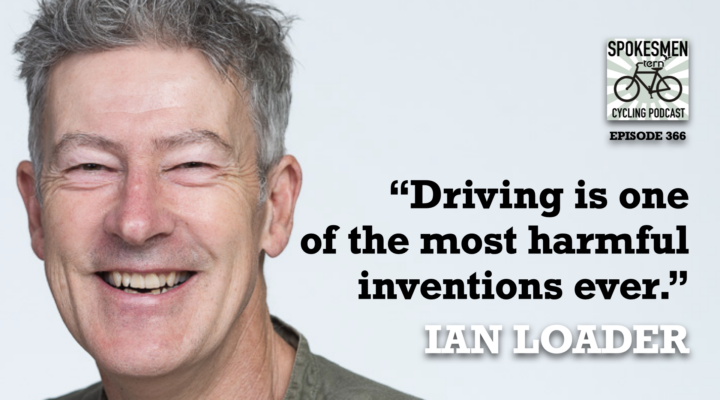
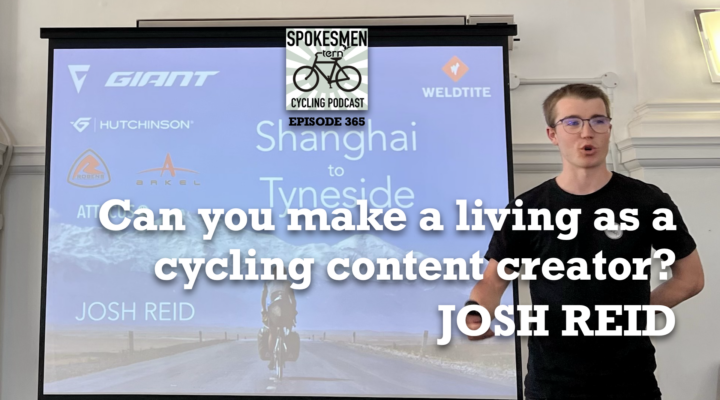
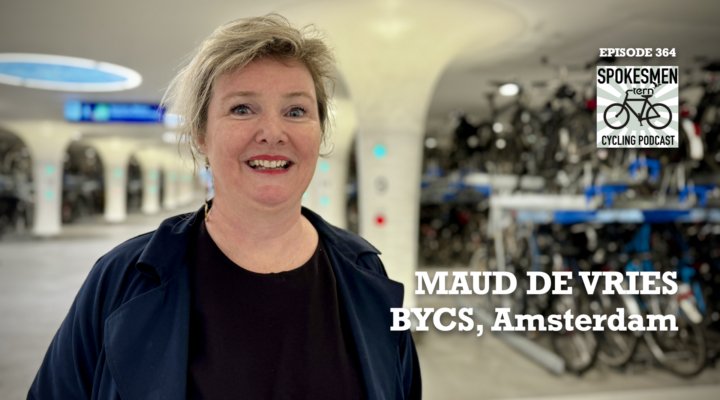
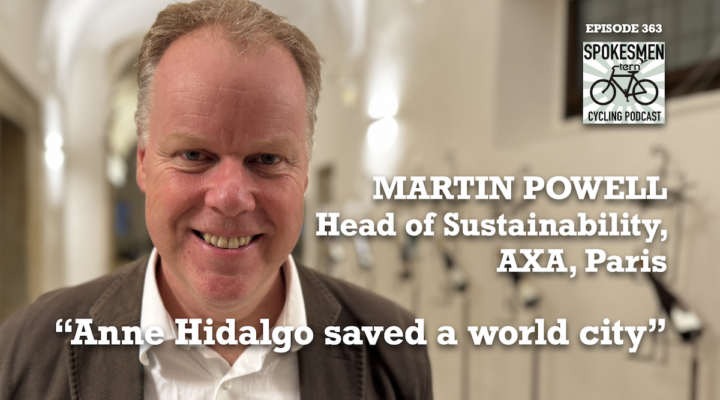
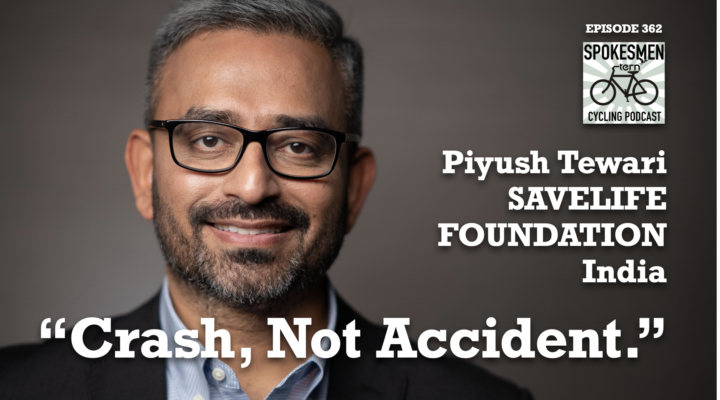
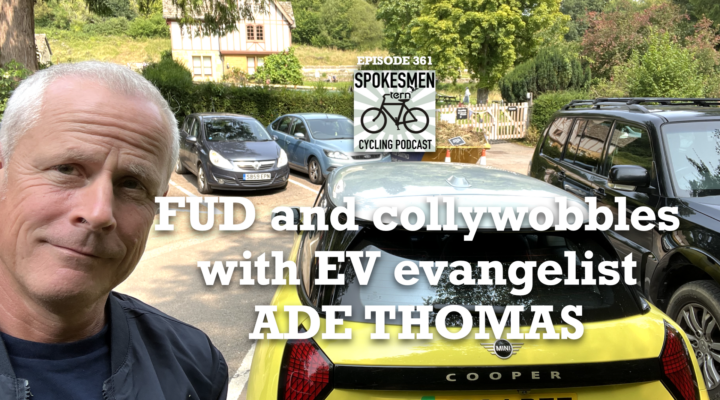
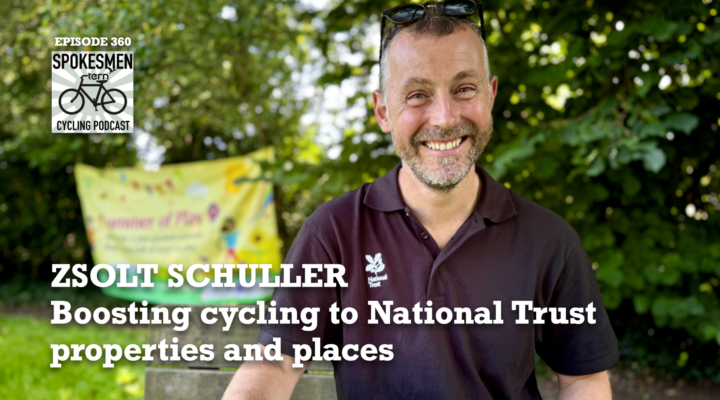
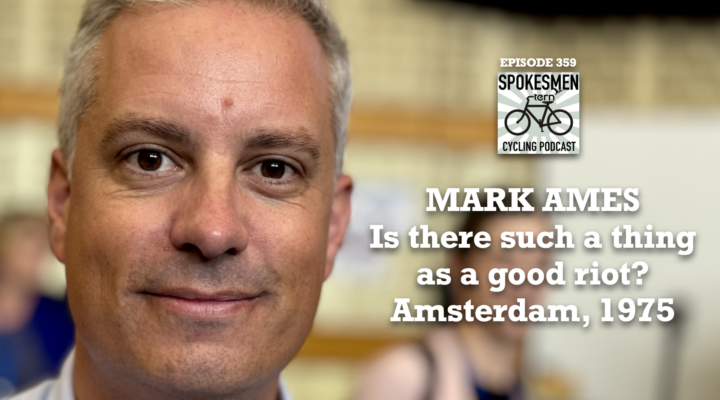
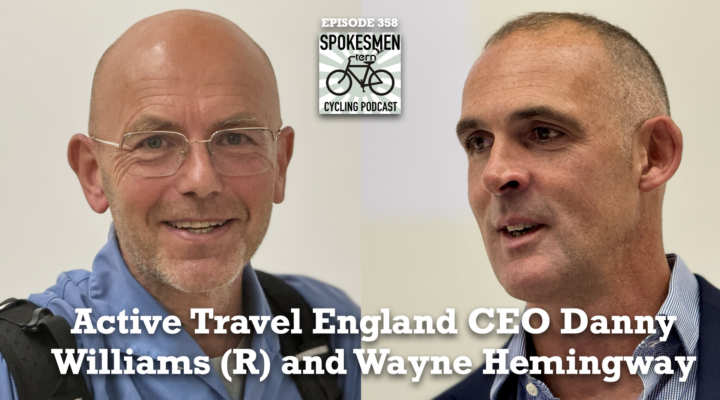
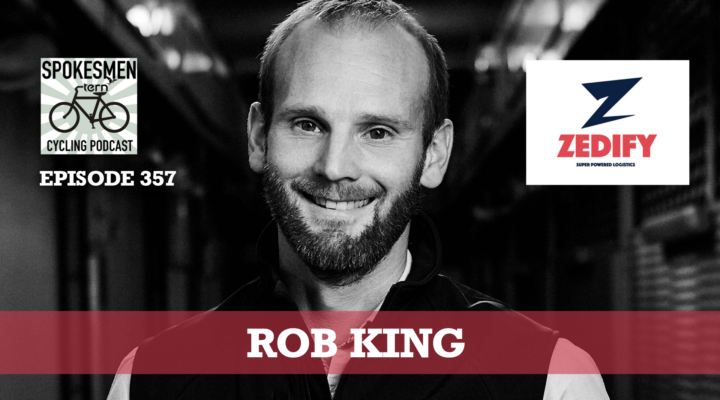
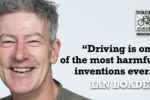
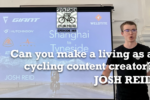
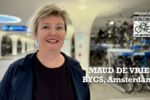
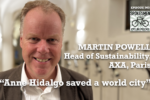
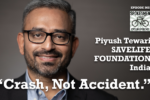
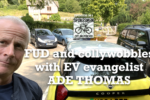

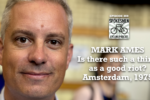
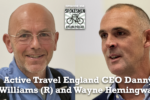

Be First to Comment